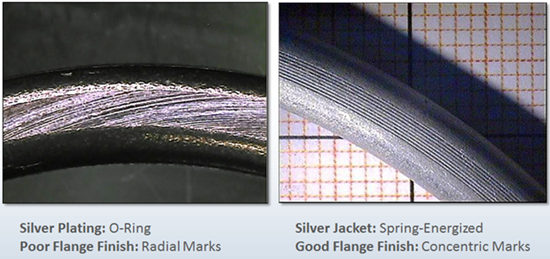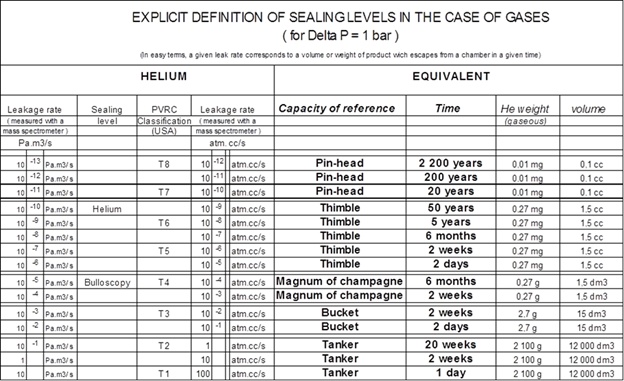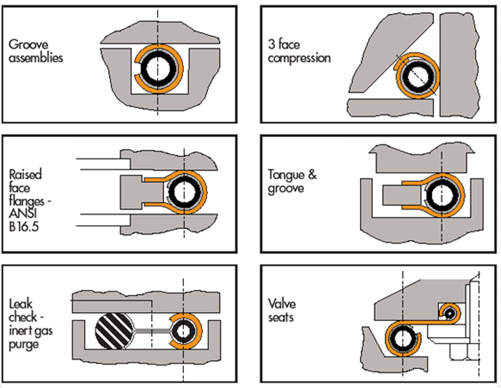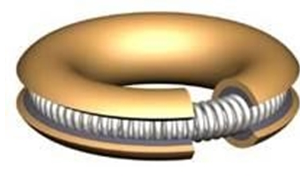Design Considerations for High-Temperature Sealing
With growing pressure to combat fugitive emissions and meet strict industry regulations, understanding the latest sealing technologies and design considerations for component solutions in severe applications is becoming increasingly critical.
#standards #pressure-relief
TRACKING LEAKS
A standard metal seal leak test method is to use helium gas, which is a very small molecule. The flow rate of helium passing through the seal interface is measured and recorded in leakage units of Pa.m3/s. Below is a table that illustrates the different levels of leakage and how they relate to familiar units (Capacity of Reference). For example, 1x10 -13 Pa.m3/s relates to one pinhead of helium being dissipated over 2,200 years.
METAL SEAL TECHNOLOGIES
Metal seals combine the sealing functions of elasticity and plasticity by using an energized core and a soft, pliable outer layer. The energized core is made from high-strength alloys and can be in the form of a spring, formed “C” profile, hollow tubing or a multi-convolution bellows. Additionally, these alloys can be heat treated to give optimum strength and spring-back. The pliable outer layer can be a formed lining (aluminum, silver, copper, nickel, etc.) or a plating or coating (silver, nickel, PTFE, etc.). Furthermore, the combination of materials and profile can be customized to address each unique sealing challenge such as temperature, pressure, spring-back, leak rate and chemical compatibility.
Metal-to-Metal Concept
Traditional gaskets are often used between flat faces, which can be a problem since the seal bears the total load and limits how much bolt load can be applied. Any additional bolt load applied for system factors, such as pressure and temperature, may cause the seal to be over compressed. This configuration also subjects the gasket to excessive creep, which can cause loss of bolt load and necessitate re-torqueing.
For best performance, the use of resilient metal seals with an optimized interface known as “metal to-metal” sealing is recommended. This concept places the seal in a groove or uses a spacer/limiter to control seal compression. It also provides a barrier wall to prevent blowout in high-pressure situations. The seal is protected and has its own energizing function for sealing and creep compensation. Once the metal-to-metal contact is made, additional bolt load can be applied to address system factors without any risk to the seal.
Another important part of the metal-to-metal interface is the surface finish of the mating surfaces. While resilient metal seals are designed to have a pliable outer layer, that layer is still not as soft as an elastomer seal. Therefore, metal seals require a very specific surface finish depending on the seal material. The finish must be carefully specified for roughness and lay. Metal seals typically require a circular lay that follows the seal circumference. This allows the soft outer layer to plastically deform and flow into the finish creating a sealing barrier. Any radial machining marks or scratches become potential leak paths. In Figure 1 we can see the impression left by the mating faces in the surface of the seal.
The seal on the left shows a surface finish that breaches the seal track and creates a leak path. The seal on the right, however, shows an ideal finish that has a circular lay, follows the circumference of the seal and gives optimum performance. Be sure to note that the recommended surface finish may change based on the seal type, the materials used and the leak rate required.
Platings vs. Coatings
Most resilient metal seals rely on an electroplated outer layer such as silver or nickel. These layers are typically very thin, only .001/.002” (.03/.05 mm) thick. Sprayed coatings such as PTFE are nominally thicker at .002/.003” (.05/.08 mm) thick. The disadvantage is that the material choices are limited and the thin deposition makes the seal more sensitive to surface finish. Material choices are even more limited for large diameters and shapes.
However, a spring-energized seal can use a formed outer lining or jacket made of a selected ductile metal. These linings are much thicker and can run from .010 to .020” (.25/.50 mm) thick. This gives many more material choices and allows for a greatly thicker sealing layer, which is good for rougher finishes. Lastly, because a spring-energized seal can be made in sizes up to 300”, they are not limited by size.
These seals are not limited in size and can be made in many unique profiles for face to face sealing, three face sealing and limiter sealing (Figure 3). Complicated shapes are possible if a minimum bending radius of roughly 6 times the seal cross section is kept.
C-Ring Metal Seals
Metal C-rings use an elastic core of high-strength alloy formed into a “C” profile. The opening typically faces the system pressure, which provides an additional energizing effect. The profile can be fine-tuned by altering the cross section and wall thickness ratio. The softer outer layer is typically electroplated silver or coated PTFE. C-rings offer moderate loading force and spring-back while being uniquely suited for high pressures. However, leak rate is sometimes compromised as there often is not enough load to deform harder platings such as nickel. C-rings can be shaped but have less flexibility than the spring-energized seals.
O-Ring Metal Seals
Metal O-rings are designed for sealing high-pressure/temperature applications requiring minimal spring-back. They are made of high-strength metal tubing that is coiled, cut and welded to size. Sealing load can be adjusted by varying the cross-section and wall thickness of the tubing. O-rings can be susceptible to collapse at very high pressures. Therefore, high-pressure applications require the tubing core be pressure-balanced by drilling small holes on the pressure side. This greatly increases the pressure capability, although it exposes the inside of the tubing to any caustic or corrosive chemicals being sealed.
E-Ring Metal Seals
Metal E-rings are designed to provide low load- and high-spring-back performance in high-temperature applications. The energized core is made from high-strength alloy and has a profile like a bellows. The profile can be designed with different geometries and extra convolutions to give maximum performance. Like a C-ring, the opening is oriented toward the system pressure for the added energizing effect. However, E-rings have very low-loading force and cannot generate enough seating force to plastically yield metal platings such as silver. Instead, E-rings often are coated with a very hard coating for wear resistance since they often are used where there is significant movement or vibration. Therefore, E-rings typically have a higher leak rate than other metal seals, but serve a specific purpose in applications that require low load and high spring-back.
Graphite Laminated Seals
Seals consisting of layers of graphite and metal offer a combination of compressible and resilient materials that form a strong seal in valve seat applications. This lamellar structure often consists of alternating layers of engineered graphite and metal, such as stainless steel or duplex stainless steel. These layers are bonded to form a unitized, laminated body that can be machined into a geometry compatible with the valve seat. Laminated seals deliver the best results, in terms of low leakage rates, high-cycle life and fire-resistance, when coupled with a secondary seal such as die-formed graphite.
SUMMARY
Metal seals offer a wide range of design solutions for high-temperature service. Available in a wide range of sizes and materials, they can provide long-term sealing with no porosity and can withstand temperatures from -252oC to 650oC (up to 800oC in some specific applications) in hard vacuum to high-pressure service. However, sealing solutions must be considered early in the valve design process to ensure the right design is developed for each unique application.
Ryan McCall is product manager for high-performance metal seals at Technetics Group.
RELATED CONTENT
-
Understanding Torque for Quarter-Turn Valves
Valve manufacturers publish torques for their products so that actuation and mounting hardware can be properly selected.
-
Understanding and Selecting Valve Flanges, Pt. I: Design and Standards
Because flanges allow the assembly and maintenance of system components without the need for cutting and welding pipe, they play an important role in piping systems.
-
Control Valves for Hydrogen Applications
Proper sizing, material selection and monitoring are as important as ever.











 Unloading large gate valve.jpg;maxWidth=214)


